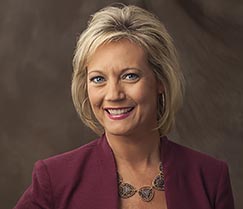The nursing shortage: A regional perspective of a national issue
by Melissa Owens, RN, MSN, Chief Nursing Officer, VP of Patient Care Services
 At an early age, my heart was set on becoming a nurse. Choosing a vocation is not easy, especially at a young age. Most students today, just as it was when I was young, aren’t sure what career path they want to follow. As for me, God gave me the desire, the gift and the opportunity to follow my calling.
At an early age, my heart was set on becoming a nurse. Choosing a vocation is not easy, especially at a young age. Most students today, just as it was when I was young, aren’t sure what career path they want to follow. As for me, God gave me the desire, the gift and the opportunity to follow my calling.
As a native of Pansey, Alabama my first experiences in healthcare happened right here, at Southeast Alabama Medical Center (SAMC) as a teenage volunteer. From the beginning, I was fascinated by the human body, the healing process, and what I could do to provide comfort and care to others. After I graduated from nursing school in Mobile, I came home. I started my professional career as a bedside nurse at SAMC. As I grew in the profession, I became devoted to learning everything I could about caring for oncology patients and building programs that would help us deliver exceptional medicine right here in Dothan.
I’ve spent 24 years dedicated to my calling, and I still get excited each day I drive in to work knowing I have the opportunity to make a difference in someone’s life. While it is a rewarding and admirable profession, there are far too few of us in the field. There is a nationwide shortage of nurses. In fact, by 2022 there could be a need for at least a million more nurses to fill the staffing voids in healthcare facilities.
The U.S. has been dealing with a nursing deficit for decades, but today, due to an aging population, the rising incidence of chronic disease, an aging nursing workforce and the limited capacity of nursing schools, the shortage is becoming a crisis, with implications for patients and healthcare providers.
Nursing recruitment and retention are two of the most important issues keeping healthcare leaders and physicians up at night. Dothan is not immune to the alarming shortage.
SAMC currently has more than 100 nursing vacancies. Other local hospitals, clinics and nursing homes also have vacancies. There simply are not enough registered nurses to meet existing needs and the ever growing demand.
Nursing Schools are at Capacity
The demand from students wanting to enter nursing school programs is high. Schools are being inundated with nursing applicants; there are just not enough open slots to handle the demand.
One barrier is that additional clinical educators are desperately needed to teach and train future nurses. In 2017, nursing schools were not able to accept 56,000 qualified applicants into undergraduate nursing programs. In the past decade, nursing schools have been unable to accept about 300,000 applicants who met admissions requirement due to a lack of open spots, according to the American Association of Colleges of Nursing.
Nursing Careers Are Rewarding
Three million nurses currently make up the largest segment of the healthcare workforce in the U.S., and nursing is currently one of the fastest growing occupations.
Benefits include average salaries as high as $97,000 a year for a nurse practitioner. Other benefits of nursing include schedule flexibility and the ability to choose what part of the country you want to work in. Nurses have opportunities to work a variety of schedules, some of which offer long shifts in return for multiple days off.
SAMC’s Efforts to Address the Nursing Shortage
SAMC’s nursing team is 900 strong, and we are aggressively recruiting. Nursing retention has been and will remain a top priority. We are committed to becoming the employer of choice for nurses and have taken proactive steps to address nursing turnover rates and the nursing shortage.
We have engaged our nursing team and with their input we developed a recruitment and retention plan that addresses key areas, including:
- Early Recruitment – We are focused on attracting new graduates by employing them prior to graduation in a nurse tech program. In addition, SAMC offers a signing bonus and student loan forgiveness.
- Compensation – Increased pay for bedside nurses, which makes SAMC the highest paying hospital in the Wiregrass.
- Career Ladder – Providing career mobility through a stair-step career progression model.
- Recognition – Programs that openly recognize and reward high performing nurses.
- Orientation – Our orientation program was enhanced, allowing new graduates more transition time and protected training time.
In addition to these efforts, SAMC has committed to decreasing nurse-to-patient ratios. This means that each nurse on a general medical surgical unit will be asked to care for fewer patients. Once fully implemented, we believe this change will significantly impact nurse satisfaction, but more importantly, patient satisfaction, safety and quality.
Each day I am grateful for the nurses who dedicate their lives to caring for others at SAMC and the greater community. While we have taken these proactive steps, there is more to be done. We are committed to continuing to explore options that help attract, train, and retain highly qualified nurses and recent graduates.
______________________________________________
This is part of an ongoing series covering the impact of changes in healthcare in our region.

